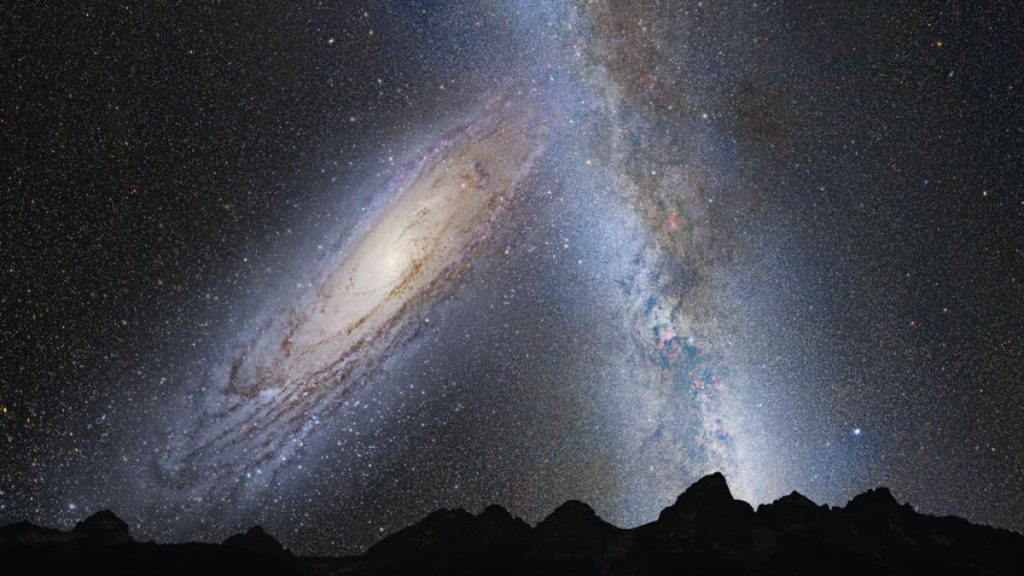
Our galaxy might crash into Andromeda. What would happen to us? (Image Credit: Mashable)
It has grown by consuming other galaxies. Yet, it too, may be destined to collide and merge with an even bigger galaxy: Andromeda. Though galaxy collisions are normal events and NASA suspects this collision is inevitable (in billions of years), new research argues that with our current knowledge about Andromeda, such a future impact is still not certain — and has about 50-50 odds.
You might wonder what would happen if our disk-shaped spiral galaxy were to one day collide with Andromeda, which is over twice the size of the Milky Way. Astronomers anticipate such a cosmic crash would ultimately create a giant, egg-shaped galaxy.
But what would happen to the stars and planets of the Milky Way? And what would be the destiny of Earth?

Credit: NASA
The Milky Way and Andromeda collision
Such a galactic collision doesn’t sound pretty.
After all, these objects pack at least hundreds of millions of stars, millions of black holes, and likely trillions of planets. If you were, hypothetically, standing on a rocky world like Earth, would catastrophe be imminent?
Thankfully, no.
Galaxies collide because they harbor unimaginable amounts of gravity, and are attracted to each other. “It’s very likely that a galaxy will encounter a galaxy comparable or smaller over the course of its lifetime,” Diego Muñoz, an astrophysicist at Northern Arizona University, told Mashable.
Yet these encounters don’t spell doom for a solar system like ours. “The solar system will in all likelihood be almost unaffected,” Muñoz said.
“The solar system will in all likelihood be almost unaffected.”
A prominent reason why is because space is immensely vast; there are huge distances between the stars, and stars are comparatively tiny. “In fact, if you were to shrink the sun to the size of a sand grain, the distance to the nearest star would be measured in miles. That makes close encounters with other stars extremely unlikely, even during a galaxy merger,” Sally Dodson-Robinson, a planetary scientist at the University of Delaware, told Mashable.
What’s more, stars and their solar systems can’t match the gravitational power of the greater galaxy. Solar systems will orbit around the galaxy’s core — just like our system completes an orbit around the Milky Way every 240 million years —and aren’t pulled into one another as galaxies merge.

Credit: NASA / JPL-Caltech / R. Hurt (SSC / Caltech)

Credit: NASA / ESA / B. Williams and J. Dalcanton (University of Washington, Seattle)
The impact between the older galaxies, however, may spawn some stellar activity as the galaxies’ gasses collide and condense. The resulting weighty clouds of gas can collapse, driving the formation of new stars.
“It will create some fireworks,” Nelson Caldwell, an observational astronomer at the Center for Astrophysics Harvard & Smithsonian, told Mashable.
What will change after a galactic collision
A galactic collision won’t violently throw planets and stars around like billiard balls. But it will change things — some visibly.
When hundreds of millions of stars merge, objects are reorganized. Stars and their planetary systems may move to a new place. The sun, for example, could end up much farther away from the center of its new egg-shaped galaxy, called an “elliptical galaxy,” Muñoz said.
And our literal view of the cosmos — if we were around to see it — would likely change considerably. “Planets will keep on orbiting as usual, though the constellation patterns visible from each planet will change,” Dodson-Robinson said. Andromeda would also gradually become a dominant, imposing feature in our night sky, as NASA has depicted in visualizations. The giant galaxy, just a faint (but poignant) presence in the sky today, would grow larger and larger, eventually colliding with the Milky Way and stoking vivid star formation.
Eventually, after billions of years, a view from Earth, or a planet like Earth, may look like the view depicted below: the bright center of an enormous elliptical galaxy.

Credit: NASA
These changes in the sky, of course, wouldn’t be rapid. They’d happen over billions of years. An immensely long-lived civilization may observe these incredible cosmic changes, but not the relatively short-lived lifespan of a person. “Any individual person would not be able to see things moving,” Jackson Taylor, a PhD student at West Virginia University researching pulsars, exoplanets, and gravitational waves, told Mashable.
It’s not certain, however, this space event will occur, according to some popular new research, mentioned above. That’s because both the Milky Way and Andromeda inhabit a “local group” of galaxies, and two in particular (M33 and the Large Magellanic Cloud) may exert gravitational influences that deter such a collision. There are still too many unknowns to say, with certainty, what will happen in billions of years, the researchers argue. After all, similar to weather forecasting today, a small error or inaccurate assumption will amplify over time, dramatically deviating from the initial prediction.
“In the full system, we find that uncertainties in the present positions, motions, and masses of all galaxies leave room for drastically different outcomes, and a probability of close to 50 percent that there is no Milky Way – Andromeda merger during the next 10 billion years,” the researchers, whose paper is under peer review (a process of healthy scientific scrutiny), wrote.
Yet Earthlings, if we manage to avoid self-annihilation and persist for billions of years upon our shape-shifting continents, might still never witness such a merger — from Earth, anyhow. In some 5 billion years’ time, the aging sun will have vastly expanded into a red giant star, either boiling away our oceans or consuming us entirely.
“The sun will be much older,” Muñoz noted, “but that’s a different problem.”
Topics
NASA





